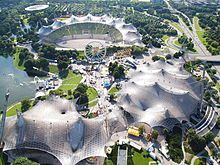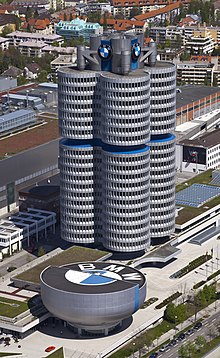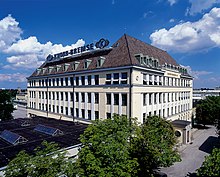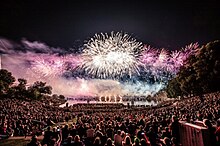Milbertshofen-Am Hart
|
Milbertshofen-Am Hart
State capital Munich
Coordinates: 48 ° 11 ′ 54 " N , 11 ° 34 ′ 35" E
|
|
|---|---|
| Area : | 13.42 km² |
| Residents : | 76,670 (Jan 31, 2020) |
| Population density : | 5.715 inhabitants / km² |
| Postcodes : | 80807, 80809, 80937, 80939 |
| Area code : | 089 |
|
Location of the city district 11 in Munich
|
|
Milbertshofen-Am Hart is the city district 11 of the Bavarian capital Munich .
description
District 11 extends as a narrow strip between Ingolstädter and Schleißheimer Strasse from the city limits in the north to Petuelpark in the south. Between Heidemannstrasse and Euro-Industriepark , a small area east of Ingolstädter Strasse also belongs to this city district. In the south-west (in the Am Riesenfeld area ), Milbertshofen-Am Hart also encompasses most of the Olympic site up to Landshuter Allee in the west, the Münchner Nordring to Wilhelmine-Reichard-Straße in the north and Willi-Gebhard-Ufer / Ackermannstraße in the south . It consists of three sub-districts: Milbertshofen, Am Riesenfeld and Am Hart.
Neighboring districts are Schwabing-Freimann in the east, Schwabing-West in the south, Neuhausen-Nymphenburg in the southwest and Moosach and Feldmoching-Hasenbergl in the west. The municipality of Oberschleißheim borders in the north .



Southeast part - Milbertshofen
The southeastern part of the city district, Milbertshofen , comprises the area of the eponymous city of Milbertshofen, which was incorporated into Munich in 1913. Since industrialization started relatively early there, a mixture of industry, trade and living was created with a high proportion of social housing. 20,165 people live in Milbertshofen [2016]. The Euro-Industriepark is located on Ingolstädter Strasse . Due to the renovation of many residential complexes and new construction of modern apartments, the differences to neighboring northern Schwabing have recently been blurring . Since the traffic on the busy Petuelring has been routed underground through the opening of the Petuel Tunnel , Schwabing and Milbertshofen have been connected by the Petuelpark green corridor. The generation garden is located north of the park . The Milbertshofen cultural center was opened in 2005 and the adjacent Curt-Mezger-Platz was named in 2007 . A weekly market takes place there every Friday from 1 p.m. to 6 p.m.
Southwest part - Am Riesenfeld
Am Riesenfeld is the (south) westernmost of the three sub-districts of Munich's Milbertshofen-Am Hart district. 27,049 people live there [2016]. In it lies the Olympic Park with the 56 meter high Olympic Mountain, the 291 meter high Olympic Tower , the Olympic Hall , the Olympic Stadium , the Olympic Swimming Pool , the Olympic Ice Sports Center , Bavaria's largest beach volleyball facility, the Sea Life Munich , the former Olympic village , the student quarter Oberwiesenfeld , the quarter Am Oberwiesenfeld , the sports center of the ZHS and the Technical University as well as the Bavarian Olympic base . The dense development in the Olympic village enables quiet, child-friendly living, as car traffic within the residential area runs in the built-up basement below the pedestrian level. The museums BMW Group Classic , BMW Welt , BMW Museum and the memorial site of the Olympic assassination are located on Riesenfeld . The BMW four-cylinder is located on the Petuelring . The headquarters of Knorr-Bremse are located on Moosacher Strasse . The Giesinger Bräu brewery is located on Detmoldstrasse . Before the site was opened from 1966 to 1972 on the occasion of the XX. Olympics was completely redesigned in 1972 , it was called Oberwiesenfeld and housed a large airfield on which the aircraft engines manufactured by BMW in the neighboring plant were tested until 1945 .
Northern part - Am Hart
The northern part of the district Am Hart (north of Munich's north ring) used to belong mainly to the Feldmoching community ; only Kaltherberge and adjacent areas on today's Ingolstädter Strasse were part of the Milbertshofen community. 29,041 people live on the Hart [2016]. Since the 1990s, the Nordhaide settlement has been built for several thousand residents on the southwestern part of the open space that still exists there, the Panzerwiese . In the north there is the hardelwood forest area . A number of former workers' settlements from the interwar period, such as the Harthof , Am Hart (scenic Hart, wooded hill), Kaltherberge and Neuherberge are also characteristic. The Bavarian State Office for the Protection of the Constitution is located on Knorrstrasse . The Bundeswehr Medical Academy is located on Neuherbergstrasse . Opposite the Research and Innovation Center (BMW FIZ) on the corner of Knorrstrasse and Troppauer Strasse, a sculpture is reminiscent of the so-called Milbertshofen Jewish settlement . The Euro-Industriepark is located in the south of the district . The Mira shopping center opened in 2009 and the 2411 cultural center opened in 2012 . In 2016, the Munich North Gymnasium , an elite sports school, was established.
General
Milbertshofen-Am Hart has the highest number of jobs in the manufacturing industry of Munich's city districts. The main BMW plant and the associated research and innovation center (FIZ) play a decisive role in this . The middle class - including many civil servants and academics - is represented by a majority in the Olympic village. The city district is very multicultural and has the highest proportion of foreigners in Munich with 40.2 percent. The service sector, especially in the western part of the Euro industrial park , and the public sector with the new police headquarters in Upper Bavaria and the Bavarian State Office for the Protection of the Constitution are now also more strongly represented. The previously strong gap in the social structure between the individual districts has been leveled out over the past three decades. The city district still has a high proportion of families with children. Around 28 percent of the area is green, with the Olympic Park and the Panzerwiese making a significant contribution.
history
Milbertshofen was first mentioned in 1149 or 1152 as "Ilmungeshoven". The word probably emerged from Illungshof's deliberately unclear pronunciation . Illungshof was the name of a hermit farm to which one was forcibly resettled - because of illness or as a punishment; understandable that the residents did not necessarily want to make this known. Further interpretation: Hof des Ilbunch / Ilbung / Ilmung or Höfe der Ilbunge. The first mention of this name happened in a document with which around 1140 Count Konrad I von Valley handed over his entire property at Ilmungeshofen to the Schäftlarn monastery for the salvation of his and his parents' soul . Because the area of this donation could only be used as pastureland, the monastery turned it into a cattle yard, i.e. a Schwaige, which was named after St. George St. Georgenschwaige.
The St. Georgenschwaige also included peasants who had to pay taxes, whose grains were stored in the storerooms of the Fronhof, administered by a master and lay brother, until they were ground in nearby mills. As a meal he received part of the grain brought, which was called the mill mazze . So it was soon called Mühlmazzhof, from which the place name Mühlmatzhofen - Milbertshofen - arose. Later names were: 1310 Mülingshoven, 1325 Mülbenhoven, 1336 Mulmantzhoven, 1465 Mülmetzhoven and 1468 Milberzhofen. Milbertshofen was in monastic hands for over 300 years.
Between 1466 and 1630 the property belonged to the Keferloh family. In 1658 Milbertshofen was sold to Elector Maximilian II Emanuel for 30,000 guilders . On January 10, 1668, Elector Ferdinand Maria raised the "St. Georgenschwaige zu Milbertshofen" to the rank of Hofmark .
After Milbertshofen had been just a Schwaige for centuries , the expansion of the later district of Munich did not begin until 1800, when Elector Max IV. Joseph handed the estate over to four Waldsassen farmers. A church belonging to Schwaige was first mentioned in 1360. Remnants of the old Georgskirche , built in the early 16th century, are the only remaining witnesses of Milbertshofen’s nucleus. The center of early Milbertshofen is located on Alten St.-Georgs-Platz between Moosacher Straße and Motorstraße. Around 1800 Milbertshofen only had 432 inhabitants.
Since the end of the 19th century, the Oberwiesenfeld was a landing site for balloons and airships, both military and civil. With the increased number of aircraft, the Oberwiesenfeld was used as an airfield from 1909. In 1932, around 16,000 passengers were handled in Oberwiesenfeld, and in the next five years the number of annual passengers tripled to around 40,000 passengers a year.
In 1905 the TSV Milbertshofen was founded. In 1910 Milbertshofen received city status. Just three years later, on April 1, 1913, the city of Milbertshofen was incorporated into Munich. A year earlier, the New St. George's Church on Milbertshofener Platz had been inaugurated.
From 1917 to 1974 the Alabama Depot was located at Am Hart. In the 1980s it became known throughout Germany as a cultural venue under the name Alabama Hall .
During the Nazi dictatorship, from 1941 onwards, there was a barrack camp in Milbertshofen for Jewish citizens, who were deported from there to various concentration camps . Erected from March to August 1941, from September 1941 to August 1942 it served as a residential ghetto for the Jewish residents of Munich, who had meanwhile been “demented”, and finally as a collection camp for the deportations. The first two large deportations from Munich on November 20, 1941 to Kaunas (Lithuania) and on April 4, 1942 to Piaski (Poland) took place from the nearby Milbertshofen train station .
In 1941 and 1942 respectively, the high bunker Lerchenauer Straße , high bunker Anhalter Platz , high bunker Riesenfeldstraße and high bunker Schleißheimer Straße were built according to plans by Karl Meitinger .
From 1968 to 1972, large parts of the Oberwiesenfeld were converted into an Olympic Park for the 1972 Olympic Games . Since then (as of November 2015) over 11,500 events with more than 200 million visitors have taken place there.
In the 1970s and 1980s, the Munich punk scene met in the mite center, in the backyard of Nietzschestraße 7b . The punk band Freizeit 81 also played there .
The Milbertshofen cultural center was founded in 2005 and the 2411 cultural center in 2010 .
On June 11, 2008, the district committee decided to rename the district to Milbertshofen-Am Hart-Olympiadorf , but this was postponed indefinitely at a later meeting at the request of the city administration. The aim was to prevent confusion in the event of a possible bid for Munich's application for the 2018 Winter Olympics and the then necessary construction of a new Olympic village.
In June 2019, Giesinger Bräu opened its new brewing facility in Detmoldstrasse with a deep well for Munich water and a capacity of 40,000 hectoliters per year.
politics
The district committee of Milbertshofen-Am Hart was last elected on March 15, 2020. The distribution of seats is as follows: SPD 10, Greens 9, CSU 8, FW 3, AfD 2 and FDP 1. Of the 48,723 residents who are entitled to vote in Milbertshofen-Am Hart, 17,747 exercised their right to vote, bringing the voter turnout to 36.4 percent lay.
Culture, religion and education
- Attractions
- BMW Museum , BMW Welt (Petuelring 130) and BMW Group Classic (Moosacher Straße 80)
- Olympiahalle Munich , Olympic tower
- Sea Life Munich , Willi-Daume-Platz 1
- Munich Olympic Walk of Stars , Willi-Daume-Platz
- Cube in Petuelpark , Klopstockstr. 10, Petuelpark
- Memorial site of the Olympic assassination attempt , Kolehmainenweg
- Cabaret Wirtshaus am Hart , Sudetendeutschestraße 40, corner of Aussiger Platz
- Theater Unterwegs (touring theater) Dieter Henkel GmbH, Connollystraße 20
- Kino am Olympiasee, Coubertinplatz 1
- Institutions
- Kulturhaus Milbertshofen , Curt-Mezger-Platz 1 (Keferloher / corner Schleißheimer Straße)
- Cultural center 2411 , Blodigstrasse 4
- Medical Academy of the Bundeswehr , Neuherbergstrasse 11
- District center Milbertshofen, Piccoloministraße
- Leisure center Neuland, Neuherbergstr. 90
- Diakonie Hasenbergl
- Play and meeting center am Hart, Arnauer Straße 5
- Munich City Library Milbertshofen, Schleißheimer Straße 340
- City center north, Troppauer Straße 10 of the Munich Adult Education Center
- Generation garden , Ricarda-Huch-Straße 4
- schools
In Milbertshofen-Am Hart there are the grammar schools: Gymnasium München-Nord and the Lion-Feuchtwanger-Gymnasium , the vocational schools: Schulzentrum Nordhaide and Adolf-Kolping-Berufsschule München, the secondary school: Balthasar-Neumann-Realschule, as well as the elementary school at the Bad -Soden-Strasse 27.
- Churches
In Milbertshofen-Am Hart there are the Roman Catholic churches: Old St. George's Church , New St. George's Church , St. Lantpert , St. Gertrud , the Dominic Center and To the Fourteen Holy Helpers , the Evangelical Lutheran Churches: Church of Thanks and Reconciliation , as well as the Ecumenical Church Center in the Olympic Village .
Architectural monuments
Sports
- Olympic Park
- Olympic Training Center Bavaria
- TSV Milbertshofen - traditional club in the north of Munich
- Central university sports facility, with over 125,000 students and over 17,000 active participants per semester, the largest university sports facility in Germany
- Sports center of the Technical University
- Athletics Support Center Munich, Motorstrasse 35
- Munich Caribes , baseball club
Green spaces
Around 28 percent of the area in Milbertshofen-Am Hart are green spaces, including:
- the parks: Harthofanger , Korbinianplatz , the Olympiapark and the Petuelpark with its northern extension: Christoph-von-Gluck-Platz, Aussiger Platz, Oberhofer Platz
- the approx. 200 hectare large heath area Panzerwiese
- the eco-area at the Munich Olympiastadion station
- the 115-hectare forest area Hartelholz
statistics

(As of December 31, residents with main residence)
| year | Residents | including foreigners | Inhabitants per km² |
|---|---|---|---|
| 2000 | 60,265 | 20,094 (33.3%) | 4,506 |
| 2001 | 61,034 | 20,372 (33.4%) | 4,564 |
| 2002 | 61,655 | 20,800 (33.7%) | 4,610 |
| 2003 | 61,886 | 21,154 (34.2%) | 4,628 |
| 2004 | 63,076 | 21,773 (34.5%) | 4,717 |
| 2005 | 64,612 | 22,896 (35.4%) | 4,831 |
| 2006 | 66,992 | 23,355 (34.9%) | 5,009 |
| 2007 | 67,864 | 23,903 (35.2%) | 5,075 |
| 2008 | 68.198 | 24,105 (35.3%) | 5,096 |
| 2009 | 68.023 | 23,683 (34.8%) | 5,070 |
| 2010 | 68,970 | 24,373 (35.3%) | 5.141 |
| 2011 | 70,470 | 25,517 (36.2%) | 5,253 |
| 2012 | 72.506 | 27,197 (37.5%) | 5,404 |
| 2013 | 73,617 | 28,243 (38.4%) | 5,487 |
| 2014 | 74,667 | 29,253 (39.2%) | 5,565 |
| 2015 | 75,488 | 30,362 (40.2%) | 5,627 |
| 2016 | 76,255 | 31,334 (41.1%) | 5,684 |
| 2017 | 74,731 | 30,147 (40.3%) | 5,570 |
| 2018 | 75.094 | 30,621 (40.8%) | 5,597 |
| 2019 | 76,559 | 31,601 (41.3%) | 5,706 |
Source with further data
Personalities
- Sons and Daughters of the Borough
- Georg Apfelbeck , German building contractor and table tennis functionary
- Thomas Kastenmaier , German soccer player and coach
- Wilhelm Pflüger , priest in the resistance against National Socialism (1906–1967)
- Otto Steidle , German architect and university professor
- Wrought in the borough
- Curt Mezger , German-Jewish entrepreneur and head of the Milbertshofen Jewish camp
- Ludwig Petuel Sr. , Mayor of Milbertshofen and operator of the Salvator beer brewery and schnapps distillery
- Ludwig Petuel jun. , Businessman and sports promoter
- Karolina Petuel , founder of the Ludwig and Lina Petuel Foundation , who supports disabled and old citizens of the city under the administration of the Munich Social Department.
See also
literature
- Beate Freytag, Alexander Franc Storz: Milbertshofen - The history of the district from the Schwaige to the suburb of Munich . Buchendorfer Verlag Munich, Munich 2004, ISBN 3-934036-80-5 .
Web links
- Milbertshofen district - state capital Munich
- Am Hart district - state capital Munich
- City District and District Committee 11 Milbertshofen-Am Hart - City of Munich
- Milbertshofen-Am Hart cultural history trail - City of Munich
Individual evidence
- ↑ Population status 01 2020 (PDF). Retrieved March 3, 2020.
- ↑ https://www.citypopulation.de/php/germany-munchen_d.php
- ↑ http://www.muenchen.de/dienstleistungsfinder/muenchen/1078240
- ↑ https://www.citypopulation.de/php/germany-munchen_d.php
- ↑ https://www.tz.de/muenchen/stadt/milbertshofen-am-hart-ort43344/vom-schandfleck-zur-beachvolleyball-anlage-auf-internationalem- level-8715181.html
- ↑ https://www.sueddeutsche.de/muenchen/muenchen-giesinger-braeu-oktoberfest-bier-milbertshofen-1.4487084
- ↑ https://www.citypopulation.de/php/germany-munchen_d.php
- ↑ [1] (PDF; 425 kB). Statistical Office of the State Capital Munich. Retrieved November 11, 2015.
- ↑ http://neubau-muenchen.com/2014/08/08/munchner-stadtteile-im-portrait-milbertshofen
- ↑ http://www.total-lokal.de/pdf/80331_89_01_10_02.pdf
- ↑ http://www.muenchen.de/rathaus/Stadtverwaltung/Direktorium/Stadtarchiv/Publikationen/Von-Allach-bis-Zamilapark/Einleitung-Geschichte/Bezirk11.html
- ^ A b Christian Jocher-Wiltschka: History, data, facts. In: sueddeutsche.de . November 7, 2011, accessed October 13, 2018 .
- ↑ http://www.total-lokal.de/pdf/80331_89_01_10_02.pdf
- ↑ Milbertshofen - Am Hart. In: sueddeutsche.de . May 11, 2012, accessed October 13, 2018 .
- ↑ Archived copy ( memento of the original from October 29, 2017 in the Internet Archive ) Info: The archive link was inserted automatically and has not yet been checked. Please check the original and archive link according to the instructions and then remove this notice.
- ^ Wilhelm Volkert (ed.): Handbook of Bavarian offices, communities and courts 1799–1980 . CH Beck, Munich 1983, ISBN 3-406-09669-7 , p. 601 .
- ↑ http://www.muenchen.de/aktuell/200-millionste-besucher-olympiapark.html
- ↑ Nicole Graner, Milbertshofen: A whole quarter in your pocket. In: sueddeutsche.de . April 14, 2016, accessed October 13, 2018 .
- ↑ https://www.sueddeutsche.de/muenchen/muenchen-giesinger-braeu-oktoberfest-bier-milbertshofen-1.4487084
- ↑ a b c Election of the District Committee - District 11 - Milbertshofen-Am Hart . State capital Munich. Retrieved May 1, 2020.
- ^ Archive district information . State capital Munich. Retrieved January 6, 2019.
- ↑ http://www.kirchenundkapellen.de/kirchenpz/vierkirchen-zwilhelmpflueger.htm

















